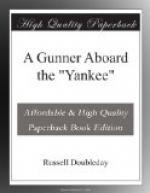After the bombardment the “Dolphin” remained at her station, firing occasionally at the batteries ashore. She was directly opposite a cut in the cliff, through which runs a little railway connecting the iron mines with the dock in Santiago harbor. During the bombardment, a train loaded with Spanish troops remained in the cut, and at its conclusion attempted to leave. It was espied by the “Dolphin” and driven back. It tried the other end with like results, and for an hour this game of hide-and-seek was kept up, to the discomfiture of the train. While waiting for the train to appear at either end, the gallant little gunboat shelled a small blockhouse, and in time disabled it. Then she steamed back to the fleet and reported that she had “wrecked a trainload of troops and dismantled a blockhouse.” When she left for her station again she was applauded by the whole squadron. We learned later that one hundred and fifty men were killed on the train.
Shortly after supper the “Yankee’s” whaleboat was called away and sent to the flagship, returning an hour later with sealed orders from the admiral.
At midnight we quietly steamed from our station and passed out to sea, our destination being unknown to all save the commanding officer.
CHAPTER XII.
In search of Adventure.
When a man-of-war sails from port under what are called “sealed orders,” which means that the orders given to the captain by the admiral are not to be opened for a certain number of hours, or until the ship reaches a certain degree of latitude, there is a mystery about the affair which appeals strongly to the crew.
We of the “Yankee” felt very curious as to our destination when we left Santiago that night, and the interest was greatly stimulated by the discovery, before we had gone very far, that the “St. Louis” and “Marblehead” were following us.
The “Rumor Committee” went into active session without delay.
“Bet I can guess it,” said “Stump,” as a half dozen of us met in the gangway. “We are bound for a cable station somewhere.”
“To cable the news of the fight?” said Flagg.
“No. That was done by one of the other ships.”
“What then?”
“To get permission from Washington to go ashore and reclaim all that steel we wasted in the bombardment.”
There was a laugh at this sally.
“I have been figuring on the cost of the fight,” remarked “Hay,” after a pause. “A five-inch shell is worth $60, and as we fired about two hundred and fifty, it means just $15,000 worth of five-inchers alone.”
“Then there are the six-pounders.”
“They cost $20 a shot,” resumed “Hay,” reflectively. “I guess we must have fired about a million of them.”
“Hardly that,” smiled Tommy, “but we expended enough to bring the total up to $18,000 at the very least. War is a costly thing, boys.”




